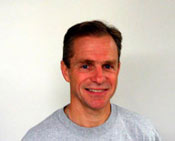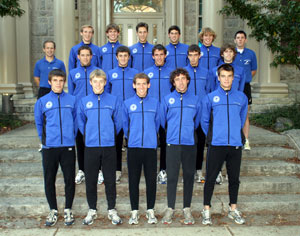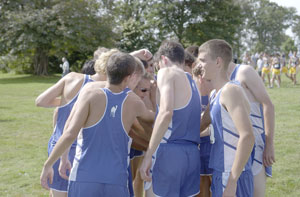Jim Butler has been the head Cross Country coach at Connecticut College for over 25 years, leading the Men’s team to the National Championships in 2002 where he was then named the Division III New England Coach of the Year.

He’s coached multiple All-American and regional champion runners, been named the NESCAC (New England Small College Athletic Conference) Coach of the Year, and is in the New London Athletic Hall of Fame.
During his own racing career, Butler posted a 2:36:48 marathon best while qualifying for the Boston Marathon 20 times. As one of the top runners in Connecticut in the 1980’s, he won the 1983 Connecticut 24 Hour Race (running over 100 miles on an outdoor track) and has run over 50 marathons.
I was privileged to be coached by Jim Butler during my tenure at Connecticut College (Conn) from 2002 – 2006. He helped me improve my 8k cross country time from 30:21 in my first race to a lifetime best of 26:19 and become a top 10 finisher in the 3,000 meter Steeplechase during the New England Championships in 2006.
Today, Coach Butler answers your questions that were submitted via Facebook and Twitter in an exclusive interview for Strength Running.
To the interview!
***
How do you determine a runner’s best race distance? In other words, how do you figure out if a runner is best suited for the mile or the marathon?

The 2005 Cross Country team at Connecticut College (I’m the short guy front and center)
I sit down every year before the start of the Indoor Track season and then before the Outdoor Track season and discuss with each individual what event or events they want to focus on. I may have an opinion based on having observed workouts that a guy should try to qualify for a certain championship in a specific event, but I want their buy-in on that idea.
Their input is very important to obtain their commitment to the goal race, but if the guy is a real slug who can run all day but not very fast, I may gently encourage him to gravitate toward the 10,000 rather than the 800.
I very much believe that a variety of events competed in can keep a season interesting. So while a guy may consider himself a specialist in one event, the plan we set up for each athlete has them racing different race distances throughout a season, always with the goal in mind to get him in the best condition to race the event they wanted to focus on at the end of the season.
Post college, and based on my own experience, I would encourage older runners starting out to try a little of everything as well. You should not set a goal that you will become exclusively a marathoner; run races of varying distances and build up to the marathon by running some 10Ks, 15Ks or half marathons.
What’s the most common (but preventable) running injury? What training strategy would you recommend for staying healthy?
This might be the question that gives me the most pause because I don’t think I can identify just one. At the college level, we see all
sorts of injuries including those that are very serious and season-ending (like stress fractures), to minor nagging annoyances like
plantar fasciitis and achilles tendonitis.
Of course these smaller injuries, which might not actually prevent a runner from training, can become more serious if they are not recognized, communicated to the coach, and treated appropriately. That might mean a period of alternative training (like pool running).
I think a lot of injuries in young runners can be prevented with proper preparation and consistent build-up over long periods of time. One strategy I have employed for a long time now is to have our guys run their mileage almost excusively on trails and other soft surfaces. When I first started coaching, almost all of their distance training was on the roads because that is what runners did and what I had done myself; now more than 90% of their miles are done on the trails in and around the college.
What are the top race strategies that you recommend? Do they differ based on an athlete’s mentality?
Yes, I do think the strategy a runner employs is based on their own mentality and on their personal strengths and weaknesses. I also believe that race strategy must be flexible and consider the distance of the race and the competition in that particular race.
I have coached some runners who are very adaptable and can react to whatever is thrown at them over the course of a race, and others who would fall apart mentally if the race does not go according to plan. I have always tried to have my runners prepared for every eventuality, including the fact that there may be an eventuality that we did not anticipate.
I recall a long time ago hearing legendary Coach Bill Squires say that he would have Bill Rogers and his Greater Boston Track Club teammates practice fake surges during training sessions, so they would be steeled and prepared to react to changes in pace they had to cover to avoid being dropped during a race.
So in terms of my top racing strategies, I would say while a runner should have a plan like “go out hard” or “sit back and wait,” he should then be ready to throw it out the window depending how the actual race develops.
Most importantly, I drill in to my guys’ heads the fact that they trained as hard as they can, and they can handle whatever comes their way during a race. That confidence is the best strategy I can impart to them.
Finally, what is the one indispensable element to making a distance runner the “best runner they can be?”
If you were to ask my athletes at Conn, they would respond with one of my favorite words when it comes to training: “Mileage“. That’s because I believe in a volume based training approach, which presupposes there is no substitute for hard work. Our guys are conditioned to do as much as is necessary to get better, and they have seen our most accomplished athletes have success by running big miles.
Please don’t misunderstand, optimal mileage for one runner is different than optimal mileage for another runner. Our freshmen do less than upperclassmen, and our Cross Country runners that specialize in the 800/1500 during Track season typically run lower volume in the fall than our 5K/10K specialists.
Along with volume, I constantly preach about the importance for our runners to do all the “little things”. This includes core work, drills, strength training, stretching, proper warm-up and warm-down, good nutrition, adequate rest and recovery, healthy lifestyles, etc.
To be more succinct, there are no shortcuts to being a good distance runner. I think the recent resurgance in distance running in the United States is due to the fact that we are now going back to our roots and our top athletes are willing to work as hard as the rest of the world.
***
Thank you to Jim Butler for sharing 25+ years of coaching wisdom and nearly 40 years of personal experience in this interview. His guidance helped me mature as a runner and form the foundation of my understanding of the sport. And I’m still coming for his 2:36:48 marathon PR!
There are countless actionable lessons you can take from this interview to improve your own running. What is your favorite piece of advice here – and why?
Photo Credit to Connecticut College